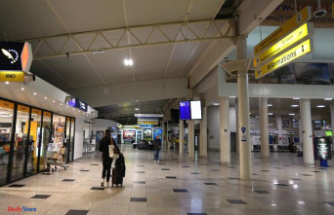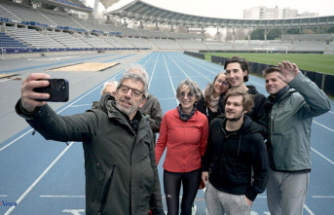An exhibition about his journey to the French front in World War I
"we Were behind the fence, to where we had come slogging like worms through a tube-soaked mud viscous. Curled up in a hole atisbábamos the German line, wanting to discover a movement either, a sign of activity, to perceive a voice, a noise... Nothing! A dead silence weighed on the field (...) Thought of the poor soldiers forced to live months and months under the ground, such as moles, vigilant as snakes, innervated by the stalking".
a Lot of before you lead one of the two sides of the Civil War, Manuel Azaña (Alcalá de Henares, spain, 1880 - Montauban, 1940) knew first-hand the disaster of another great war, the highest that until then had known the human being. As secretary of the Ateneo of Madrid, performed a series of trips to various fronts of the Allies during the First World War. The destruction that he witnessed made him aware that something had to be done and, in his turn, captured their experiences in a series of conferences and in a chronicle, Our mission in France, published in the Bulletin Hispanique, in the winter of 1917.
Of those trips Azaña brought with it a series of photographic plates of glass, taken in collaboration with the press agencies working for the French army, which illustrated the devastation caused by German bombing raids. These images were intended to shock a few spaniards then enjoyed the relative calm of neutrality. Those plates have disappeared, but were rediscovered later in the Loft of the Ateneo de Madrid, the institution that now exposes them, accompanied by the texts of the chronicles and conferences, in the exhibition Manuel Azaña in Reims and Verdun. Impressions of a trip to France (1916).
The sample has been carried out in collaboration between the Ateneo, the University of Alcalá de Henares, Fundación Francisco Largo Caballero, the city council complutense and the Fundación General of the University alcalaína, who was in charge of the restoration of the pieces centuries old. After passing through Montauban, a town where rest the remains of Azaña, the exhibition now comes to the place where it all began, curated by Jesús Cañete Ochoa.
"Verdun is a pile of rubble," describes Azaña one of the images. "There are houses that have been cracked from top to bottom as a hack and show the inner half of their homes with furniture and open appliances and housewares in domestic is still at the place of use. This gives the impression of a disaster that instantly had finished there with human life." However, "no photograph can give an idea of the state of destruction in which the city is located, because you then become old, next the ruins was added to the ruins and the rubble are applying. All of this has an aspect torvo".
Cañete Ochoa explains that, "of the Spanish intellectuals, Azaña was the one who knew more about the war and the one who visited most times the front. Traveled in October of 1916 to France along with Américo Castro, Ramón Menéndez Pidal, Rafael Altamira. Then he visited the Italian front in September of 1917, with Miguel de Unamuno. And at the end of the year he returned to France in the company of Ramon Casas and Santiago Rusiñol, amongst others." It was, according to the commissioner, "an advocate of the allied cause and was committed to it." As well, delivered in January 1917, in the Athenaeum the conference, Reims and Verdun (Impressions of a trip to France), located the scene of destruction. The plates they brought were "sort of like a power point to illustrate their words," explains Cañete Ochoa. However, "calls on the public not to stay with the picturesque". For the future president of the Republic, "was destroying the best thing that had won the european civilization".
Destruction of the "european cultural heritage"The cathedral of Reims was the place of coronation of the French monarchs. And the germans were ready to fund the destruction of the city, just like in Verdun. "The first thing that surprises you", abounds with the commissioner on the impressions of Azaña, "is the annihilation, the number of dead and injured. And also the destruction of the european cultural heritage, understood as heritage, that which we do not belong to anyone and that we must bequeath to future generations".
Also called attention to the situation French army, which, two years after plasmaría in a book of studies of military policy gala. Then it describes: "Hormigueaba the troop under the trees, busy in their chores: wash, cut firewood, clean up the horses. Some men made it to the toilette in the open air, showing his naked torso: other, lying on the ground, they smoked quietly. It was, in the end, an intense activity and vigorous; the full life of the war, of which we did not see the horrors. All those roads channeled the fruit of the national energy, absorbed, sucked, pouring a few steps from there into the furnace which consumed without have finished it".
All this had a clear purpose: "to mobilize; its mission was that Spain would break neutrality and enter the war", says the curator of the exhibition. "While the posture of Valle-Inclán and Unamuno could be compared to the chroniclers of war, in the case of Azaña was distinctly political against the neutrality". To not achieve that goal, "during the Civil War feel the surrender to the allied powers, that he interpreted, in part, as a consequence remote of the lack of intervenció"".
But Azaña was the Great War with another lesson. "What he discovers there, and what you are going to be a confrontation with Negrin and general Vicente Rojo, is the idea that since there are no decisive battles. Verdun is a battle of attrition, of resistance." In the Civil War, pointing Cañete Ochoa, "I expected there to be a to mark definitely the course of the contest, but even as it happened with the Battle of the Ebro. Azaña is aware that the military strategy contemporary is not going to by that side".
Also marveled with the networks of civil protection and the important role of women and of immigrants (vietnamese mostly) in the war effort. An industry coordinated that caused her to admiration, and that would mark its subsequent renovation project of the Spanish army. "Not culminated and the consequences are that we all know," says the commissioner.
According to the criteria of
Learn more Date Of Update: 22 December 2018, 08:00











